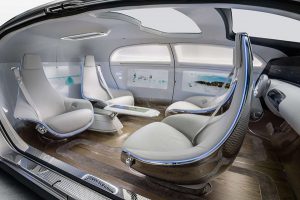
The (Near) Future of Luxury Cars
While luxury styling may not be for everyone, there’s a definite sense of exclusivity to these vehicles, and I imagine that luxury cars will embrace far more adventurous designs than their mass-appeal cousins at the low-end of the market.
LEAD WITH STYLE
One key advantage of luxury cars is that they’re sold to a smaller audience who is often looking to distinguish themselves with the look of their vehicle. These owners want people to notice their cars, and want something they can feel is unique and distinctive. With that in mind, the future could see luxury cars becoming even more dramatically styled than ever.
A good example of this is what Lexus has done in the last few years, moving from cars which frankly started to look not much different from their Toyota cousins (like the Avalon for instance), toward designs which are much more bold and aggressive. Just look at the difference in styling between the 2017 Lexus LS 500 and the flagship sedan’s replacement that’s coming in 2018.
PUSH THE PERFORMANCE ENVELOPE
One area that will continue to rule the roost when it comes to high-end vehicles is drivetrain performance and capability. We now live in an era where it’s not uncommon to see luxury sport sedans and coupes with 0-to-60 times less than 4 seconds, and where a 400 horsepower engine is at the low-end of the performance spectrum. As turbochargers and superchargers become more efficient, expect smaller engines to produce even faster rides, and the use of lightweight materials like carbon fiber and aluminum, which are still expensive to produce, to dominate in the high-end market.
Another area which is dramatically changing the driving landscape is the availability of hybrid gas/electric and pure electric drivetrains. When powered properly, electric motors can offer substantial amounts of instant torque, making for impressively quick acceleration that gas engines could only hope to achieve. While these technologies are also finding their way to less expensive cars, the focus there has and will be on fuel efficiency. In the premium market, it’ll be all about acceleration. We already have million dollar plus hybrid hypercars like the Porsche 918 Spyder, Ferrari LaFerrari, and the McLaren P1, and hybrid technology has also appeared in the latest Acura NSX as well.
MATERIALS, MATERIALS, MATERIALS
There was a time when a car had leather seats and a soft dashboard, it was a “luxury” model. Now, nicely stitched leather can be had as an option in a Hyundai Elantra, and soft touch surfaces are ubiquitous as well. To combat this, luxury automakers are looking to more expensive and unusual materials. More and more luxury interiors include Alcantara or other softly sueded fabrics, which not only look great, they resist glare and prevent you from sliding around in your seat. Fancy trims from exotic woods, aluminum, and carbon fiber are transforming interiors as well, and these are unlikely to ever be affordable enough to include in less expensive vehicles.
In addition, materials are being manipulated in new ways to provide a more premium appearance, through the sculpting and layering of surfaces, complex and laborious stitching of materials, and even high tech approaches like embedding flexible OLED into curved surfaces, providing new ways for drivers and passengers to not just view information and entertainment, but to create visual interest.
AUTONOMY
There’s a whole lot in the news about self-driving cars, but the reality is that the technology required to pull off such a feat safely must be very sophisticated, and embedded into dozens of systems if a car is to be fully capable of driving itself. The research and development costs are extremely high, and the regulatory and legal hurdles will be high as well.
That said, the two most likely places we’ll see true autonomy in the next 10 years or so will be in commercial fleets (where companies can make a business case for the expense), or in high-end luxury vehicles. We’re already starting to see components of autonomy with systems that can maintain speed and keep you between the lines, and some luxury manufacturers have gone as far to offer systems that can take care of pretty much everything while sitting in a traffic jam. Additionally, Tesla claims that every Model S currently rolling off the assembly line has all the hardware needed to support full autonomy.
For luxury car buyers who either want to be driven so they can relax, get work done, or just so they can have the latest in technology and convenience, full and partial autonomy will be on the list of go-to features for premium automakers in the next decade.
WHAT ELSE?
There will surely be other changes in the car industry in the coming years which will affect the way we experience vehicles, from the ability for cars to communicate with systems in your home, to alternative fuels that could change the way cars are powered. If truly self-driving cars become available, the interiors might change to be less car-like, and more living-room like. What I’m pretty sure we won’t be driving any time soon are the flying cars we saw on The Jetsons.
